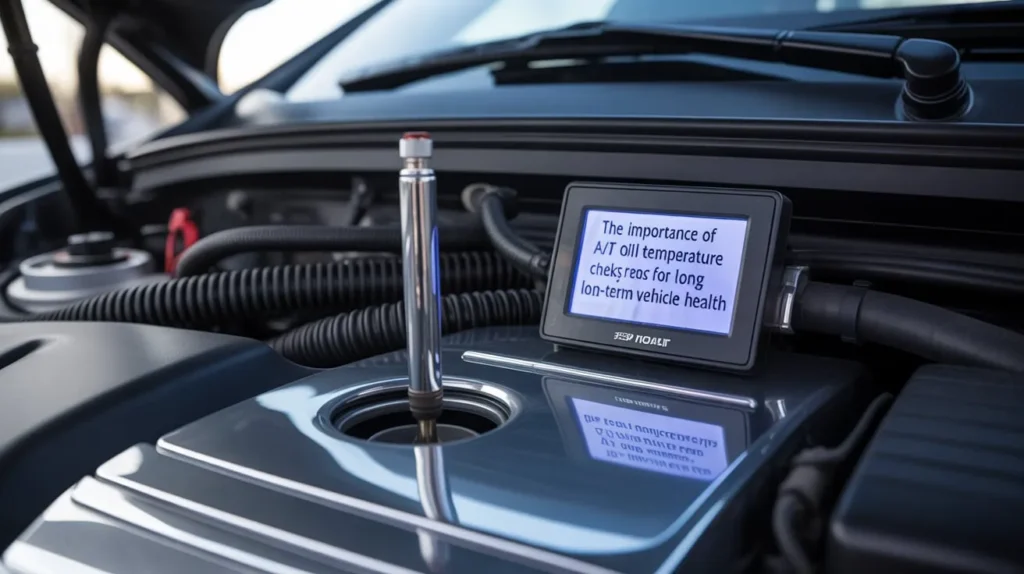Maintaining the A/T oil temperature in your Toyota Tundra is crucial for the longevity and performance of your vehicle. Overheating can cause serious damage to your engine, leading to costly repairs. The automatic transmission (A/T) oil plays a key role in keeping the transmission running smoothly, ensuring optimal driving performance. If the oil temperature is too high, it can indicate problems such as low oil levels or poor cooling efficiency. Regularly monitoring the A/T oil temperature can help you avoid these issues, maintain transmission health, and keep your Tundra running smoothly for years. Keeping an eye on the temperature is simple yet essential to protect your investment and ensure engine efficiency.
In this guide, we’ll discuss how to monitor your Toyota Tundra’s A/T oil temperature, why it matters, and the steps you can take to keep it within the optimal range. Keep reading to protect your Tundra’s transmission.
Introduction to A/T Oil Temperature in Toyota Tundra
Understanding the importance of A/T oil temperature is crucial for every Toyota Tundra owner. The A/T oil temperature is a vital indicator of the health of your automatic transmission. If the oil gets too hot, it can lead to the breakdown of the transmission fluid, causing the gears to slip or even fail. Keeping the A/T oil temp within the optimal range helps prevent serious issues and ensures smooth performance for years to come. Monitoring the oil temperature regularly can help you spot problems early, saving you from expensive repairs.
What is A/T Oil Temp, and How Does It Affect Your Toyota Tundra?
A/T oil temp refers to the temperature of the automatic transmission fluid that keeps your transmission running smoothly. Transmission fluid helps to cool and lubricate the parts of the transmission, reducing friction and wear. If the oil temperature becomes too high, it can degrade the fluid, leading to poor lubrication and higher friction between moving parts. This can cause your transmission to overheat and eventually fail. Therefore, monitoring your Toyota Tundra’s A/T oil temperature is a preventive measure that helps protect your vehicle from unnecessary damage.

Signs of Overheating A/T Oil Temp in Toyota Tundra
High A/T oil temperature is often a sign of a potential problem. Some signs of overheating include:
- Warning lights on your dashboard
- Strange noises when shifting gears
- Slipping or delayed gear shifts
- A burnt smell from the transmission fluid
If you notice any of these signs, it’s important to check your Toyota Tundra’s A/T oil temperature immediately to avoid serious damage to the transmission.
Why is Maintaining Optimal A/T Oil Temp Critical for the Toyota Tundra?
Maintaining an optimal A/T oil temperature is crucial for several reasons:
- It ensures proper lubrication of the transmission components.
- It helps prevent friction and wear that could damage internal parts.
- It avoids transmission overheating, which could lead to costly repairs or even total transmission failure.
Keeping the A/T oil temp within the optimal range guarantees your Toyota Tundra delivers smooth, reliable performance, especially under heavy loads or towing conditions.
How to Monitor A/T Oil Temp in Toyota Tundra?
There are several ways to monitor the A/T oil temperature in your Toyota Tundra:
- Check your dashboard: Some models have an integrated A/T oil temp gauge.
- Use an OBD-II scanner: This device connects to your vehicle’s diagnostic port and gives you real-time data on various parameters, including A/T oil temp.
- Install an aftermarket gauge: If your Tundra doesn’t have one, you can install a dedicated gauge to monitor the temperature at all times.
By using one of these methods, you can keep an eye on your A/T oil temperature and take immediate action if needed.

Common Causes of High A/T Oil Temp in Toyota Tundra
Several factors can contribute to high A/T oil temperature in your Toyota Tundra:
- Low fluid levels: Insufficient transmission fluid can lead to higher temperatures.
- Old or degraded fluid: Transmission fluid that has broken down loses its cooling properties, leading to overheating.
- Heavy towing: Towing heavy loads increases the strain on the transmission, causing higher fluid temperatures.
- Poor cooling system: A malfunctioning transmission cooler can fail to regulate the temperature of the fluid.
Understanding these causes will help you take preventive steps to avoid overheating and maintain your Toyota Tundra’s A/T oil temperature within safe limits.
How to Prevent A/T Oil Temp from Rising Too High in Toyota Tundra?
To keep your A/T oil temp in check, follow these tips:
- Change transmission fluid regularly: This ensures the fluid stays clean and effective at regulating temperature.
- Use high-quality transmission fluid: Quality fluids have better thermal stability, which helps prevent overheating.
- Monitor fluid levels: Low fluid levels can lead to higher temperatures, so always check and refill when necessary.
- Install a transmission cooler: This helps keep the A/T oil temp within the ideal range, especially when towing or hauling heavy loads.
By following these practices, you can significantly reduce the chances of your Toyota Tundra’s A/T oil temperature rising to dangerous levels.
What to Do If Your Toyota Tundra’s A/T Oil Temp Is Too High?
If you notice your A/T oil temp is too high, follow these steps:
- Pull over safely and allow your vehicle to cool down.
- Check the transmission fluid levels and top up if needed.
- Inspect the fluid for signs of contamination or degradation. If the fluid appears burnt, change it immediately.
- Check for leaks in the transmission cooler or lines.
- Visit a mechanic: If the problem persists, it’s important to get professional help to diagnose and fix the issue.
Taking these immediate actions can prevent further damage to your Toyota Tundra and keep the transmission in top condition.

The Importance of Regular A/T Oil Temperature Checks for Long-Term Vehicle Health
Regularly checking your A/T oil temperature helps ensure that your Toyota Tundra’s transmission system stays in good condition. Over time, neglecting oil temperature checks can lead to wear and tear, which may result in expensive repairs. By incorporating routine checks into your vehicle maintenance schedule, you can extend the life of your transmission and avoid costly repairs.
Best Practices for Maintaining Transmission Fluid and A/T Oil Temp
To maintain proper A/T oil temp, follow these best practices:
- Change fluid as per the manufacturer’s recommendations.
- Use the right type of fluid for your Toyota Tundra.
- Inspect fluid levels regularly.
- Use a transmission cooler for heavy towing or off-road driving.
Following these practices helps to keep your A/T oil temp stable, promoting better transmission performance and a longer vehicle lifespan.
Tools and Devices to Help Monitor A/T Oil Temp in Toyota Tundra
Several tools can help you monitor your A/T oil temperature:
- OBD-II Scanners: These devices allow you to read transmission-related data, including oil temp, from your vehicle’s computer.
- Transmission Fluid Temperature Gauge: A dedicated device that constantly monitors the A/T oil temp in real-time.
- Smartphone Apps: Some apps can connect to your OBD-II scanner to display A/T oil temperature on your phone for easy access.
Using these tools, you can keep track of your Toyota Tundra’s A/T oil temperature and prevent overheating before it becomes a problem.
How A/T Oil Temp Affects Towing and Heavy-Duty Driving in the Toyota Tundra
When towing heavy loads or driving under demanding conditions, the A/T oil temp can rise. The increased strain on the transmission leads to higher fluid temperatures. It’s important to monitor the temperature during heavy-duty driving, especially when towing trailers, boats, or carrying heavy cargo. Using a transmission cooler or checking the temperature regularly can help prevent overheating during these activities.
FAQ:
1. What is the normal A/T oil temp range for a Toyota Tundra?
The normal A/T oil temp for a Toyota Tundra usually ranges between 160°F and 200°F (71°C – 93°C). Anything above 200°F can be concerning and may require attention.
2. How often should I check the A/T oil temperature in my Toyota Tundra?
It’s a good idea to check the A/T oil temp regularly, especially before long trips or heavy-duty driving, to ensure your Toyota Tundra is running efficiently.
3. Can towing heavy loads cause my A/T oil temperature to rise?
Yes, towing heavy loads can increase the strain on the transmission, causing the A/T oil temp to rise. Using a transmission cooler can help manage the temperature during towing.
4. What are the signs that my A/T oil temperature is too high?
Signs of a high A/T oil temperature include warning lights, strange noises when shifting, slipping gears, or a burnt smell coming from the transmission fluid.
5. How can I prevent my A/T oil temperature from rising too high in a Toyota Tundra?
To prevent overheating, change the transmission fluid regularly, monitor fluid levels, use high-quality fluid, and install a transmission cooler if towing frequently.
6. What should I do if my Toyota Tundra’s A/T oil temp is too high?
If your A/T oil temp is too high, pull over safely, allow the vehicle to cool down, check the fluid levels, and consider visiting a mechanic if the issue persists.
Conclusion
Maintaining your Toyota Tundra’s A/T oil temperature is crucial for ensuring the longevity and performance of your vehicle. Regular checks, preventive maintenance, and understanding the signs of overheating can save you from costly repairs and keep your transmission running smoothly. Remember, taking small steps to monitor and regulate the A/T oil temperature can go a long way in protecting your investment and ensuring that your Tundra stays reliable for years to come. Keep your vehicle in optimal condition with simple yet effective care.

